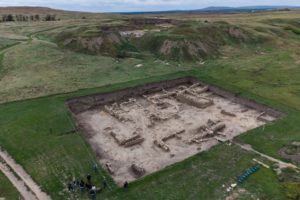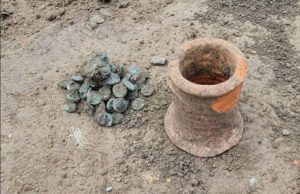
Krasnodar region, 5 August 2022 – The Phanagoria archaeological expedition, which is conducting excavations in the Black Sea region along the Taman Peninsula with support from Oleg Deripaska’s Volnoe Delo Foundation, has discovered a horde of Bosporan coins dating to the 6th century AD. This and similar finds on the Taman Peninsula allow archaeologists to make a rough estimate of the standards of living of the medieval inhabitants of the Black Sea coast and conclude that the savings of ordinary citizens were enough to last them up to one month.
A purse with 30 copper staters, a type of Greek coin minted in the Bosporan Kingdom, was found during excavations of the historical layer of Phanagoria, which dates back to the 6th century AD. Archaeologists believe that these coins were lost or hidden by the owner during a sudden attack on Phanagoria, likely by the Huns or the Turks. The cache of coins was found between two burned-out houses. Last year, a similar find – a bundle of 80 coins stashed inside an amphora by their owner – was made not far from this site.
Archaeologists have found similar treasures along the coast of the Taman Peninsula in the past. In a town that also used to be a part of the Bosporan Kingdom, called Hermonassa, a bundle of coins was found on the threshold of an ancient temple, and several dozens of them fell onto the floor inside the building. In Kitey, another Bosporan city, a pouch with coins was found in a house stove. The owner was presumably trying to stow it during a siege but never returned to pick it up.
In most cases, the findings contain several dozen Bosporan coins, with analyses suggesting that their owners parted with them in a hurry due to extraordinary circumstances. This leads archaeologists to believe that medieval inhabitants of the Taman Peninsula had approximately 30-80 coins on hand for their everyday needs. “These coins and these amounts were likely used for small transactions such as buying food or clothes,” says Prof. Mikhail Abramzon, numismatist and senior researcher of the Phanagoria archaeological expedition.
Archaeological finds in the region also suggest that the ‘savings’ of ordinary citizens of medieval cities on the Black Sea coast amounted to roughly 1,000 Bosporan coins. Based on the approximate daily expenditure of 30-80 coins, researchers conclude that, on average, such savings lasted citizens for no longer than one month. One of the largest hordes found on the territory of Phanagoria dates to the 4th century AD and contains approximately 4,000 copper and silver coins, which was a considerable fortune for that period. It likely belonged to a major craftsman or merchant.
The Bosporan coins are unique in that they were last minted in 34 AD but continued to be used in the region until at least the end of the 6th century. There is hardly any modern currency that can boast such a long lifespan. This demonstrates the large number of minted coins and their reliability as a means of payment. After Phanagoria became a Byzantine dependency, Byzantine gold also circulated on its territory, which had a higher value than the Bosporan coins. Nevertheless, unlike copper staters, gold coins were used almost exclusively for large transactions, and only the richest medieval classes could afford them. Hordes containing gold coins are usually thought to have belonged to moneylenders, merchants or major artisans.
_____________________________

The cache of coins. Phanagoria Archaeological Expedition, Institute of Archaeology, Russian Academy of Sciences, and the Volnoe Delo Foundation
_____________________________

Coin cache, cleaned. Phanagoria Archaeological Expedition, Institute of Archaeology, Russian Academy of Sciences, and the Volnoe Delo Foundation
_____________________________

Aerial view of excavation site. Phanagoria Archaeological Expedition, Institute of Archaeology, Russian Academy of Sciences, and the Volnoe Delo Foundation
_____________________________
Article Source: Volnoe Delo Foundation press release
About the Phanagoria archaeological expedition
The Phanagoria expedition of the Institute of Archaeology of the Russian Academy of Sciences is conducting archaeological excavations on the territory of the historical and archaeological museum-reserve Phanagoria. Since 2004, the excavations have been supported by the Volnoe Delo Foundation. Phanagoria is made up of 2.5 million cubic meters of cultural land, with excavations of 7,000 square meters conducted by 250 archaeological scientists, students and volunteers as part of the annual expedition. In 2014, the State Historical and Archaeological Museum-Reserve Phanagoria was established on the excavation site.
Phanagoria was founded in the middle of the 6th century BC by Greek settlers on the shores of the Taman Gulf. Its ancient settlement and necropolis include over 700 mounds and occupy 900 hectares. The city existed for more than 1,500 years and, for a long time, was one of two capitals of the oldest state formation on the Russian territory: the Bosporan Kingdom.
The treasures found in the Phanagoria mounds are stored in the Hermitage and the Pushkin State Museum of Fine Arts, as well as in museums in countries including Great Britain and Germany. The results of the expedition have been presented at international scientific forums in Germany, France, Denmark, Greece and the United States, among others. In 2009, the discovery of the palace of Mithridates VI was included in the list of the ten most outstanding archaeological finds in the world, according to Archaeology Magazine (USA).
About Volnoe Delo Foundation
Volnoe Delo is one of the largest non-profit organisations in Russia involved in charity, patronage and volunteer projects. The foundation addresses social issues, supports education and the sciences, and helps preserve the country’s cultural and historical heritage. The Foundation has supported more than 500 projects in 50 different regions of Russia to date. The projects’ beneficiaries include around 90,000 school children, 4,000 teachers, 8,000 students from universities and vocational schools, 4,000 scientists, and over 1,200 educational, scientific, cultural, healthcare and sporting institutions.
_____________________________
Advertisement




